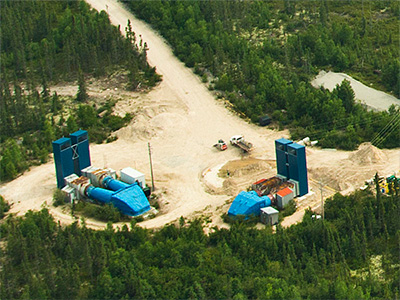Case Study
Rabbit Lake Snorkel Towers

The Rabbit Lake operation, which opened in 1975, is the longest operating uranium production facility in North America. Since then, the site has seen numerous expansions, some of which have created issues that have required creative solutions. One such problem with expansion was the recirculation of radiologically contaminated air back into the mine, which led to the suspension of work until the conditions passed.
Early in the mine’s life recirculation wasn’t an issue, but over time as the mine and the scope of mining activities grew, the problem became more and more frequent. This ultimately led to the need to find a permanent solution beyond suspending work until conditions passed.
The solution? Snorkel towers – 10-metre towers that extend the fresh air raises that draw air into the Eagle Point mine and help ensure that exhaust air is not recirculated underground, making the mine a safer place for employees.
“We were literally drawing the [snorkel] idea on a napkin and we both got super excited about it,” Mark Sherwood, manager, safety, radiation, quality for the Rabbit Lake operation recalls of a brainstorming session with former mine manager Georg Ostrop. “We realized that we could fix this problem.”
A team of 30 people – spanning the site’s radiation, mine engineering and projects departments – ran with the idea and solved an issue that had dogged Eagle Point for a decade. Recirculation occurred during the summer months when warmer temperatures trapped the contaminated air at ground level.
“In extreme cases of recirculation, the air being drawn in by the fresh air raises was too contaminated to allow work to continue and the mine was evacuated,” says Mark. “Evacuation would occur between 10 and 15 times per year and last anywhere from four to eight hours.”
That translated to a productivity loss of $1 million annually. When the project team first tackled the problem, they focused on tweaking the exhaust system. They considered using a windmill to disperse the contaminated air. They also proposed heating the air to make it rise or building a 25-metre exhaust stack to divert it from the fresh air intakes. All of those options proved cost-prohibitive. That’s when the team began exploring the idea of extending the fresh air raises instead.
“It’s a pretty simple solution, but I don’t think it was immediately obvious to everyone that it was the right solution,” says Mark. “As we continued to look at our data, we saw that the idea was easy to test and it had good potential to succeed.”
They launched a three-year plan in 2010 with the collection of air samples at different elevations. Based on their data, two 10-metre towers were erected on a fresh air raise in 2011. The success of the test towers led to the construction of five more in the spring of 2012.
“The result,” says Mark, “has been a success with no further evacuations required due to exhaust recirculation this summer.”
Project members became the first-ever Rabbit Lake winners of Cameco’s ALARA Cup. ALARA stands for “as low as reasonably achievable,” recognizing initiatives that make every reasonable effort to maintain exposures to ionizing radiation as far below the dose limits as practical.
